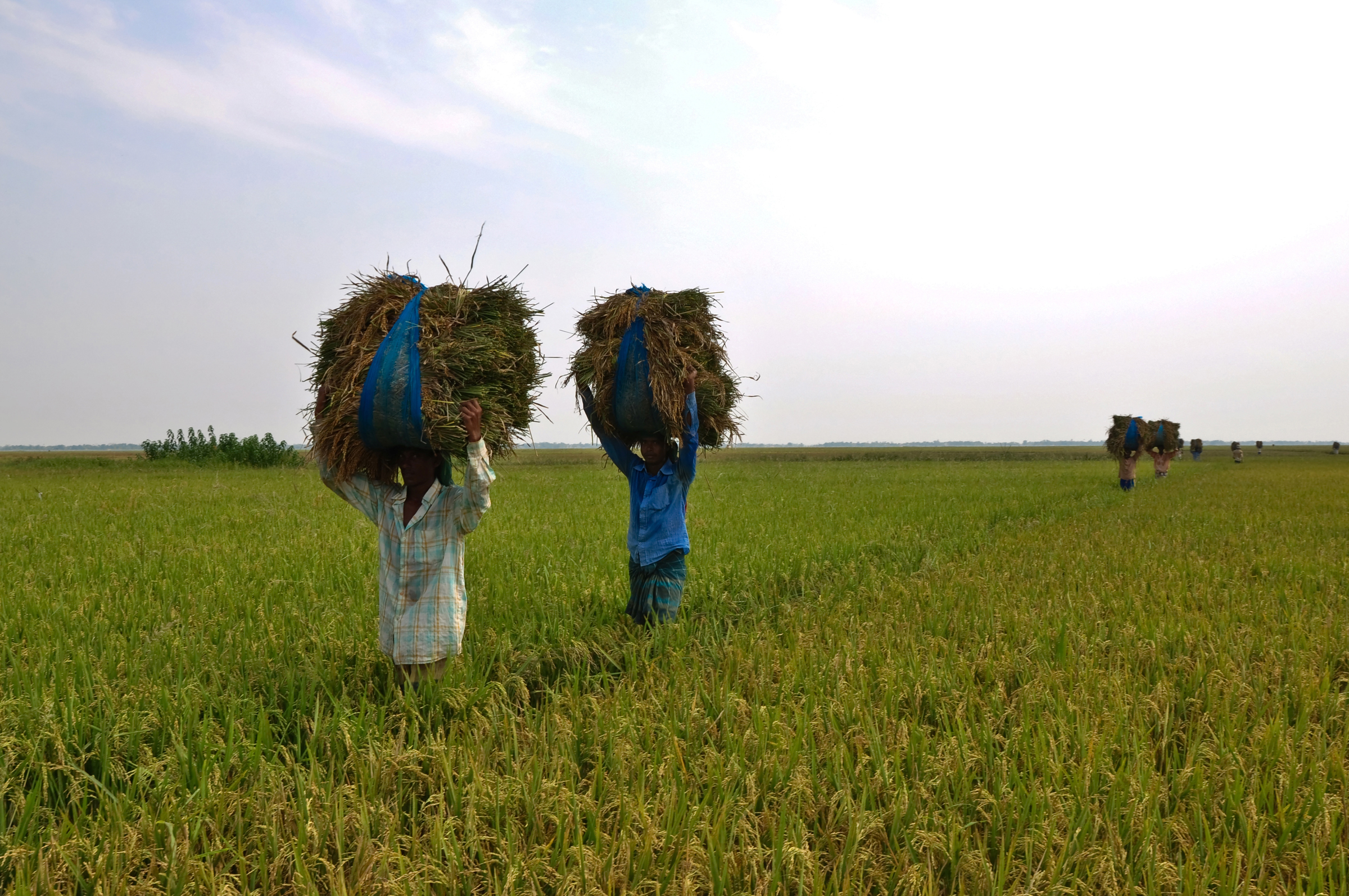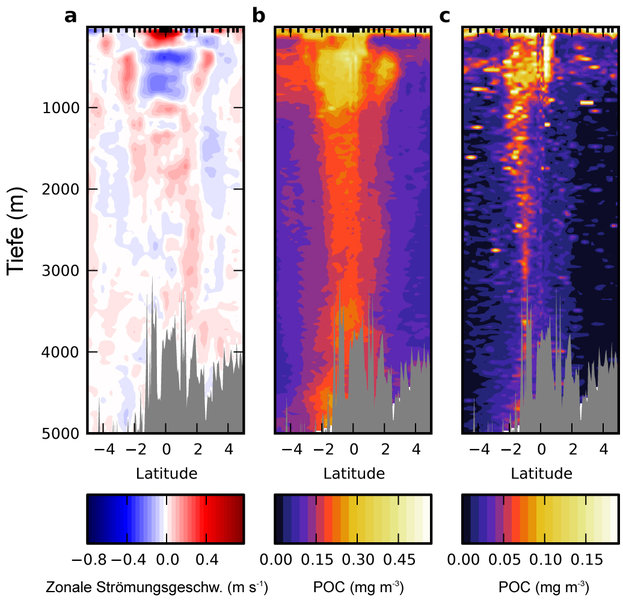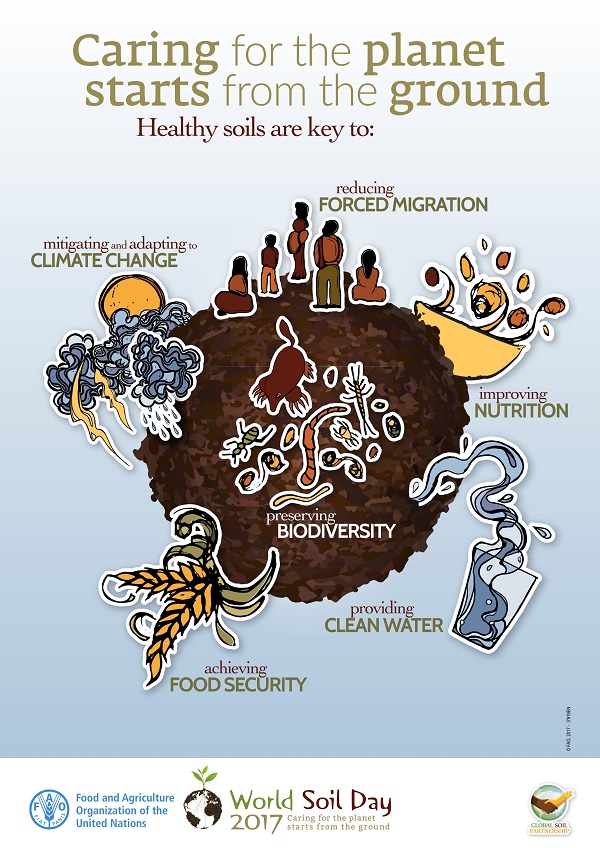
Thoughts on the World Soil Day 2013 about Bangladesh Soils
S.M. Imamul Huq
 Bangladesh is a very small country with only about 15 million ha of land but it has to take care of more than 150 million of people in providing habitation and food. The actual land: man ratio is ever shrinking and the amount of land available to a person now stands at less than 0.05 ha. This has forced the soil scientists to devote much attention to a better understanding of this natural resource so that increased food could be produced from using the best inputs. As a result the terms like sustainable soil management, food security and soil resilience have been the most pronounced and discussed topics during the last decade. If the term sustainable mean “the same forever”, then the meaning of sustainability will have little interest as the population of the country has already become unbearably large that is already putting a lot of pressure on soils. Sustainability for Bangladesh could be seen as gradual improvement and simultaneous maintenance without further degradation over a long period of time. The challenges to a sustainable land management in Bangladesh are twofold. The first one is to boost crop production and to maintain the production level while maintaining the soil quality of the agricultural lands and secondly, to alleviate the already degraded lands in such a way so that these lands are improved in a manner to an environmentally sustainable and acceptable quality. For food security the country has to restore to a sustainable agriculture. One of the key elements in a sustainable agriculture is the greater efficiency of resource use. Soil resilience relates to the ability of soil systems to return to the original state after withdrawal of stress that a soil undergoes during soil management. The stresses could generate from natural as well as anthropogenic operations. In fact, soil resilience is thought as the balance between soil’s restorative and degradative stages. The processes that are thought to be important for soil resilience are (a) maintenance of soil organic matter content; (b) improvement in soil physical and chemical properties; (c) maintenance of soil biodiversity; (d) reduction in soil degradation; (e) control of soil erosion rates below the soil formation rate; and (f) increase in nutrient reserve and recycle mechanisms.
Bangladesh is a very small country with only about 15 million ha of land but it has to take care of more than 150 million of people in providing habitation and food. The actual land: man ratio is ever shrinking and the amount of land available to a person now stands at less than 0.05 ha. This has forced the soil scientists to devote much attention to a better understanding of this natural resource so that increased food could be produced from using the best inputs. As a result the terms like sustainable soil management, food security and soil resilience have been the most pronounced and discussed topics during the last decade. If the term sustainable mean “the same forever”, then the meaning of sustainability will have little interest as the population of the country has already become unbearably large that is already putting a lot of pressure on soils. Sustainability for Bangladesh could be seen as gradual improvement and simultaneous maintenance without further degradation over a long period of time. The challenges to a sustainable land management in Bangladesh are twofold. The first one is to boost crop production and to maintain the production level while maintaining the soil quality of the agricultural lands and secondly, to alleviate the already degraded lands in such a way so that these lands are improved in a manner to an environmentally sustainable and acceptable quality. For food security the country has to restore to a sustainable agriculture. One of the key elements in a sustainable agriculture is the greater efficiency of resource use. Soil resilience relates to the ability of soil systems to return to the original state after withdrawal of stress that a soil undergoes during soil management. The stresses could generate from natural as well as anthropogenic operations. In fact, soil resilience is thought as the balance between soil’s restorative and degradative stages. The processes that are thought to be important for soil resilience are (a) maintenance of soil organic matter content; (b) improvement in soil physical and chemical properties; (c) maintenance of soil biodiversity; (d) reduction in soil degradation; (e) control of soil erosion rates below the soil formation rate; and (f) increase in nutrient reserve and recycle mechanisms.
For a densely populated country like Bangladesh with gradual increase in population and scarce and shrinking land, the terms sustainable land management, food security and soil resilience do carry a positive meaning. The soil scientists of this country have been thriving fast to achieve and materialize these over the last hundred years or so.
As the livelihood and economy of this part of the Indian sub-continent depended on agriculture, the relevant scientists used and manipulated the soil to increase the productivity without giving much emphasis on soil properties. However, as pressure for increased food production mounted due to population growth, the soil scientists started looking further deep into the soils of the region and initiated systematic study of the soils. Soil survey, soil classification, rational use of chemical and biological inputs to soil etc. emerged as priorities.
Man is dependent on good soils and good soils depend on how human beings use it.The land use in Bangladesh has evolved through natural forces as well as human needs. Cultivated land, forestland and settlements and homesteads are the major land use types in Bangladesh. With the growing population, and their increasing needs in various sectors, land use patterns are undergoing a qualitative change in which the areas under the net cropped land and forest land are gradually shrinking. A large part of the forestland is now under different types of non-forest land use like shrimp culture, unauthorized occupation for homestead, establishment of industrial units, urban super structures etc. There are no Governmental regulation on land use and development at the national level except on forest land. The Ministry of land Administration and Land reforms deals with land acquisition and land development and administer the existing laws on the subject. The relevant authorities under this ministry have been directed to exercise utmost economy in the use of land and prevent wastage and misuse of agricultural land for urban projects. Over the last decades, Bangladesh has experienced extremely high rate of urbanization exceeding more than two to three times higher than that of the national population growth rate. This rapid urbanization in Bangladesh is perhaps inevitable in a situation of globalised market economy without a national system having minimum control over the development process. Pressure on land has been on the increase over the last three decades due to increase in population, increased number of farm holdings due to inheritance and subdivision, expanding urbanisation (12 million in 1984 and 35 million in 2004), and due to acquisition of cultivable land for development projects for industrial, business, housing and other non-agricultural activities. About 1% of the arable land is declining each year due to increased urbanisation and non-farming activities in the public and private sector. As per the Ministry of Agriculture sources, each year 82,000 hectares of farm land are lost due to setting up of factories and industrial establishments, construction of roads, highways and other infrastructures, private uses. On the other hand, demand for food grains is rising at rate of 1% each year. This has put into challenge for the preservation of arable soils. The per capita availability of arable land now stands at 0.05 ha. Urbanisation has already emerged as a real threat to the availability of good soil in rural and peri-urban areas. There are instances where valuable arable lands are being degraded due to human activities. It is estimated that about 7% of the total land area of the country is experiencing degradation due both to natural and anthropogenic causes. Use of good quality agricultural lands for brickfields all over the country is a vivid example of this. Brick kiln is one of the principal agents of topsoil degradation. Brick kilns are destroying large areas of lands where bricks are manufactured by collecting soils from a depth of 1 to 2m in arable lands the extent of which in 1998-99 was more than 5000 ha spreaded all over the country. Brick burning alters the physico-chemical and biological properties and habitats of the nearby soils. Burning of soils has been found to significantly increase the Ec values and sand contents while decreasing the silt and clay contents. Organic matter contents, available N, P, K and S contents of burnt soils also decreased significantly. Land degradation negatively affects agricultural production to the tune of 2 per cent per year. Another anthropogenic mode of soil degradation in the country is the depletion of forest lands in the Chittagong Hill Tracts, Cox’s Bazar, Modhupur forest lands and Sundarban due to growing population pressure, migration of landless people in forest areas, shifting cultivation, illegal felling and excessive commercial exploitation. It is in report that more than 150,000 acres of forestland have been lost due to illegal occupation by land grabbers. Improper Cultivation in Hill Slopes, Terrace Land and Piedmont Plains is yet, another human induced land degradation. One of the most important causes of land degradation specifically in the Barind tract is over exploitation of biomass from cultivated fields. This process of land degradation is also common in other highland and medium highland areas. Mining of sand from agricultural land is common along the eastern side of the Dhaka-Chittagong road, from Comilla to near Sitakunda, and in the northern piedmont areas of northern Netrokona District. Farmers tend to enjoy the immediate monetary benefit and lease out their land for extracting sand, which is used in glass manufacturing industries or as building material. Extraction of pebbles from 2-3 feet below the surface of agricultural land is a common phenomenon in the northern part of greater Dinajpur and Rangpur districts. Industrial pollution is an area of growing environmental concern in Bangladesh. Bangladesh has at present more than 30,000 industrial units, large and small. They are discharging their wastes and effluents in the natural systems in most cases without any treatment and thereby cause environmental pollution especially due to heavy metals and organic toxins. The heavy metals that are present in the effluents may enter the growing crops from contaminated soils. On the other hand, it has been observed that peri-urban lands and lands along highways are contaminated with heavy metals through vehicular emission, application of pesticides, herbicides or insecticides, presence of heavy metals in fertilizers as impurities, application of sewage sludge, faulty irrigation water etc. that cause an elevated level of accumulation of heavy metals like Cr, Cd, Pb, Ni, Cu, Zn etc. Improper disposal of city and municipal wastes have also been found to degrade valuable agricultural lands. At present Arsenic is to be considered the single most important contaminant in Bangladesh soils. Although the average values obtained for As in soils are less than 10mg/kg, values as high as 80kg/ha has also been obtained from regions where groundwater irrigation is practiced. The annual build up through irrigation in soil has been calculated to be 5.5 kg/ha. As accumulation has been found to be elevated in crops including rice and vegetables receiving irrigation with As contaminated water. It has been identified that a vast area in the Ganges-Meghna-Brahmaputra catchment has emerged as the single largest arsenic contaminated region in the world.
This process of land degradation is also common in other highland and medium highland areas. Mining of sand from agricultural land is common along the eastern side of the Dhaka-Chittagong road, from Comilla to near Sitakunda, and in the northern piedmont areas of northern Netrokona District. Farmers tend to enjoy the immediate monetary benefit and lease out their land for extracting sand, which is used in glass manufacturing industries or as building material. Extraction of pebbles from 2-3 feet below the surface of agricultural land is a common phenomenon in the northern part of greater Dinajpur and Rangpur districts. Industrial pollution is an area of growing environmental concern in Bangladesh. Bangladesh has at present more than 30,000 industrial units, large and small. They are discharging their wastes and effluents in the natural systems in most cases without any treatment and thereby cause environmental pollution especially due to heavy metals and organic toxins. The heavy metals that are present in the effluents may enter the growing crops from contaminated soils. On the other hand, it has been observed that peri-urban lands and lands along highways are contaminated with heavy metals through vehicular emission, application of pesticides, herbicides or insecticides, presence of heavy metals in fertilizers as impurities, application of sewage sludge, faulty irrigation water etc. that cause an elevated level of accumulation of heavy metals like Cr, Cd, Pb, Ni, Cu, Zn etc. Improper disposal of city and municipal wastes have also been found to degrade valuable agricultural lands. At present Arsenic is to be considered the single most important contaminant in Bangladesh soils. Although the average values obtained for As in soils are less than 10mg/kg, values as high as 80kg/ha has also been obtained from regions where groundwater irrigation is practiced. The annual build up through irrigation in soil has been calculated to be 5.5 kg/ha. As accumulation has been found to be elevated in crops including rice and vegetables receiving irrigation with As contaminated water. It has been identified that a vast area in the Ganges-Meghna-Brahmaputra catchment has emerged as the single largest arsenic contaminated region in the world.
Soil in Bangladesh is a very limited but important natural resource. Due to agrarian nature of the society, soils of Bangladesh have been over exploited. Management of the soil resource base is of utmost importance for ensuring optimal production. So far, increase in crop production has largely been through crop intensification that includes use of HYV/Modern Varieties of crops, use of chemical fertilizers, irrigation and agro-chemicals. It is quite difficult to sustain increased production over a long period without crop extensification. Unfortunately this possibility in Bangladesh is bleak unless there is a program for land accretion in the coastal areas. Though crop production is increased due to intensification of cultivation, the sustainability of increased crop production might not keep pace with increasing population as there is stagnation of crop production or even decline in crop production even after application of recommended dose of fertilizers due to depletion of organic matter. So, it is important that good agricultural land must be managed with appropriate agronomic practices and conversion of good agricultural land must be protected. To contain the land degradation, sustain agricultural production and maintain soil health the issues to be considered for future could be: (A) soil resource inventory that will include refining of the AEZs through detailed soil surveys at the lowest administrative level; prepare thematic maps for land use planning; assess soil degradation; land zoning; (B) cropping system research to develop efficient and high intensity cropping system that is compatible agro-techniques suited to different AEZs; better understanding of the crop-weather relationships that will serve a basis for preparing crop weather prediction models; diversification of cropping systems by inclusion of high value crops for higher returns; (C) nutrient management research to maintain soil health ; increase fertilizer use efficiency; promote utilization of indigenous resources and evolve integrated nutrient management strategies for different cropping systems.
In conclusion, it may be added that Soil Survey is a cross road. Bangladesh has a very good data base on soil survey and interpretation during 1960-70. There are remarkable changes in land use in both agriculture and non-agriculture. On the other hand there are changes in the methodology and classification to harmonize with international approaches. In sixties soil survey was done to meet the work of soil scientist, which had a narrow space to meet the need of an area in different perspectives. Application of GIS, use of remote sensing tools, digitized color photography etc. have the potentials to upscale the output of the survey to be used in multipurpose field. Let us strive forward to sustain our most valuable natural resource – the soils for our future generation.
Writer: Professor, Department of Soil, Water and Environment, University of Dhaka
Founder Director, Bangladesh-Australia Centre for Environmental Research
Famous Soil Scientist of Bangladesh, and writer of the book ” The Soils of Bangladesh”




